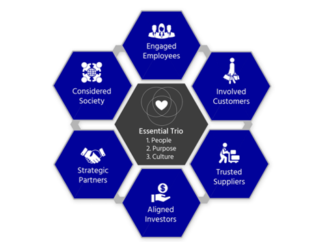
Exploring the Integrated Stakeholder Ecosystem (ISE), the next stakeholder group to look at in more detail are the suppliers and strategic partners. So what is the deal here?
Well…trend is to switch from exploitation (or win-lose) to defining win-win, synergistic and long-term partnerships, if with your suppliers or your partners. The focus changes from looking at your company success in isolation, to taking a whole-supply-chain perspective.
What do some of the most profitable companies, such as Patagonia, do to get this part of their stakeholder net right?
#1 Select them carefully
Understand how do they do business? Are they aligned with your values and apply similar practices towards their customers, employees or investors? Choosing the right partner can have not only an impact on your profit margin, but can affect your brand equity and overall positioning in the market.
#2 Set the rules
Many companies first do their due the due diligence and select the right ones to partner with, but then, they also impose strict environmental and social responsibility standards to be followed by their partners and suppliers. In the end only those that comply and stick to the defined limits are contracted, even if higher prices apply.
#3 Trust – Communicate – Support – Share
Open and trust-based cooperation and communication is another key. Further, to understand what is important for you and align on your goals is needed, in order to help each other becoming more financially successful, even if this means paying the supplier higher rates for a specific period of time, making sure they earn necessary profit margin, to take care of their employees. Some don’t only exemplar great teamwork, but they even switch from hiding “top-secret” know-how to actually having shared resources (talent, space, materials, etc.) or shared suppliers.
Recently, I experienced a wonderful case example related to this topic (which I will shorten and tweak for simplicity):
Imagine there are two companies. One producing vaccine to fight a deadly disease and save millions of people. The other one is a bio-tech company, looking to develop solution to clean up the oceans, including the oil spills, saving many endangered species. Both are in a big fight to purchase 200k eggs, being a one and only production amount for this year. They don’t communicate. Nor they partner. They fight and fight, as for both, it is essential to have the eggs to develop their solutions and make the impact they crave to make. What they don’t yet know is that one company needs the egg yolks and the other one the egg whites.
So what does this mean? They both can continue and produce their impact-making solutions. Moreover, they can partner in the future, reducing costs by half, if they continue placing the egg orders together, reducing the waste they were producing until today.
Reflection time:
How do you select your suppliers and business partners? Do you set the rules? And do you trust them, communicate with them, support them and share with them?






